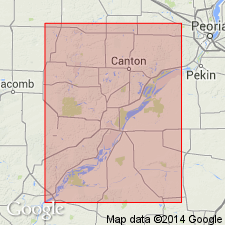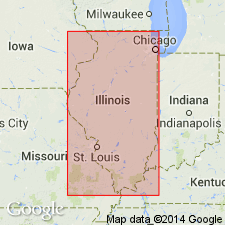
- Usage in publication:
-
- Gimlet sandstone
- Modifications:
-
- Original reference
- Dominant lithology:
-
- Sandstone
- AAPG geologic province:
-
- Illinois basin
Summary:
Pg. 50 (fig. 22), 60, 116-117. Gimlet sandstone in Gimlet cyclothem, McLeansboro group. Present in western northern Illinois. Has maximum thickness of 50 to 60 feet but is locally absent. Fills channels that cut from 50 feet above coal No. 7 to about 5 feet above Brereton limestone. Unconformable on Farmington shale. Age is Pennsylvanian.
Source: US geologic names lexicon (USGS Bull. 1200, p. 1512).

- Usage in publication:
-
- Gimlet sandstone member
- Modifications:
-
- Revised
- AAPG geologic province:
-
- Illinois basin
Summary:
Pg. 38, 49 (table 1). Gimlet sandstone member of Modesto formation (new) of McLeansboro group. Occurs above Farmington shale member and below Lonsdale limestone member. Age is Pennsylvanian. Type locality stated. Presentation of new rock-stratigraphic classification of Pennsylvanian strata in Illinois; cyclical classification is independent of rock-stratigraphic classification.
Type locality: on Gimlet Creek, in SE/4 sec. 16, T. 12 N., R. 9 E., Marshall Co., IL.
Source: US geologic names lexicon (USGS Bull. 1200, p. 1512).
For more information, please contact Nancy Stamm, Geologic Names Committee Secretary.
Asterisk (*) indicates published by U.S. Geological Survey authors.
"No current usage" (†) implies that a name has been abandoned or has fallen into disuse. Former usage and, if known, replacement name given in parentheses ( ).
Slash (/) indicates name conflicts with nomenclatural guidelines (CSN, 1933; ACSN, 1961, 1970; NACSN, 1983, 2005, 2021). May be explained within brackets ([ ]).

